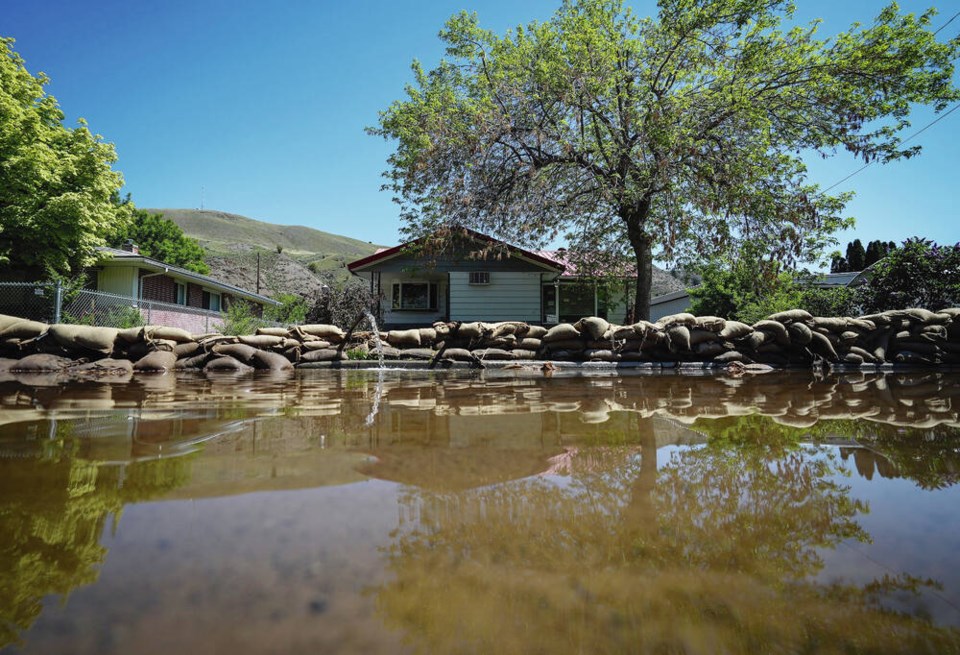Upgrades to weirs along Holland Creek west of Ladysmith are among dozens of projects intended to prevent flooding, the provincial government said Thursday as it launched a new B.C. Flood Strategy.
Bowinn Ma, minister of emergency management and climate readiness, told a news conference that the province is investing about $39 million in more than 50 projects across B.C., including $2.75 million for the weirs.
“These projects will go a long way toward keeping people and their communities safer from disasters and extreme weather events such as flooding, drought and extreme heat,” Ma said.
The funding, part of the Community Emergency Preparedness Fund, will be used for work on dike rehabilitation, reinforcing a drainage-pump system, upgrading community centres to operate as gathering places for people during extreme weather and launching watershed restoration projects.
Ladysmith developed the plan to deconstruct and upgrade weirs on Holland Creek — within a forest park that spans the heart of the community — following a recommendation from a B.C. dam safety review.
The intake weir will be repaired, allowing for a future water supply to the town’s filtration plant, a key factor in distributing safe drinking water throughout the area, Ladysmith Mayor Aaron Stone said in statement.
A lower weir will be decommissioned and two other dams upgraded to “help remove the risk of erosion along the banks, improve restoration of the creek supporting aquatic habitat, and ensure the continued enjoyment of the trail system,” he said.
Plans call for the lower weir near the Mackie Road entrance to the local trail to be deconstructed to restore the creek bed, provide a more natural passage of water and improve conditions for aquatic habitat.
The changes will reduce the risk of structural failure, the city said.
The project comes after the area was damaged by floods in early 2020. At that point, the town included upgrades to the upper intake weir in its capital plan.
It’s expected that the work will be completed this year.
Ma said the province has already provided about $214 million through the Community Emergency Preparedness Fund to First Nations and local governments for almost 1,900 projects across B.C.
News of the funding came as the province launched a new B.C. Flood Strategy to help build flood preparedness.
Nathan Cullen, minister of water, land and resource stewardship, said the province worked alongside local governments and First Nations to draft the B.C. Flood Strategy, which will be a road map to navigate climate events.
“Floods, similar to droughts, historically were very localized, very short term,” he said. “But like droughts, now we perceive, with the effects of climate change, that floods will be much larger region-wide and have much larger impacts, hence the need for a flood strategy that incorporates … all communities.”
Consultations for the new plan began shortly after a series of atmospheric rivers swamped southwestern B.C. in November 2021, washing away portions of the Malahat and several other major highways in the province. A landslide washed over a section of Highway 99, between Pemberton and Lillooet, killing five people.
One of the most devastated communities was Merritt, where a torrent of rain caused the Coldwater River to overflow its banks. The flooding caused dike failures, shutdown of the city’s water system and wastewater treatment plant, and extensive property damage, at a cost of about $150 million, the city’s website says.
Merritt flood recovery director Sean Strang said the provincial and federal governments have provided funding and support in recovery efforts, but dike rebuilding recently stalled, leaving 1,270 properties vulnerable to future flooding.
Strang said in an interview the city needs about $20 million in provincial funding to complete the project.
“At this current time, without provincial funding, we are significantly more exposed than we ever have been,” he said, noting the flood washed away dikes that were built in the 1970s.
“So, in addition to not having modern standard dikes, we don’t have old standard dikes either, and those aren’t able to be rebuilt until we get that provincial contribution.”
During the news conference, Cullen said Merritt is an example of “what happens when we don’t take care of the infrastructure over time.”
“We have funded Merritt quite significantly to this point in a number of different projects, and we’re happy to see those projects go ahead,” he said when asked about the call for dike funding. “We’ll continue to see the work happen and continue to add to the investments we’ve been making.”
Cullen said the flood strategy focus will be in four key areas: assessing flood risks with floodplain mapping, increasing communication with local and First Nation governments, better preparing for floods and response, and helping with flood resilience.
The Insurance Bureau of Canada lauded the announcement, calling it an important step as more than 200,000 B.C. households remain at “high risk of flood damage.”
The 2021 disaster, which caused about $675 million in insured flood damage, showcased the need to better understand flood risks, the bureau said.
“That event is part of an alarming trend, as insured losses in Canada due to severe weather now average over $2 billion annually.”
>>> To comment on this article, write a letter to the editor: [email protected]



